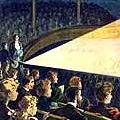The Complete History of The Discovery of Cinematography – Part 1

This subject has a rich history attached to it. In order to understand the full discovery and development of moving pictures, we must study the various elements of not only this medium, but all others which are related to cinematography and especially photography. This timeline will provide more than a substantial glimpse into the discoveries of these elements which include; optics, pinhole images, camera obscura, persistence of vision, showmen, magic lanterns, light, lenses, light-sensitive substances, phantasmagoria, motion study analysis, photography, and stop-action series photography in the overall growth of photography and ultimately, the movement of pictures.
This chronology is presented in fifteen chapters, and represents an exhaustive and historical overview on the subject of cinematography. It encompasses among others, the works of Layard, Sophocles, Herodotus, Empodocles, Mo Ti, Plato, Aristotle, Democritus, Euclid, Archimedes, Shao Ong, Vitruvius, Lucretius, Pablius Statius, Pliny, Seneca, Heron, Ptolemy, Ting Huan, Galen, Boethius, Geber, Chao-Lung, Kuang-Hsien, Alhazen, Avicena, Shen Kua, Averroes, Grosseteste, Bacon, Magnus, Witelo, Peckham, Saint-Cloud, Villeneuve, Gershon, Fontana, Alberti, Gainsborough, Vinci, Maurolycus, Caesariano, Durer, Reinhold, Gemma-Frisius, Cardano, Porta, Barbaro, Fabricius, Diggs, Risner, Danti, Benedetti, Casciorolo, Kepler, Scheiner, Sala, Snell, D’Aguilon, Drebbel, Gassendro, Schwenter, Leurechon, Bate, Kircher, Descartes, Horrocks, Herigone, Martini, De Chales, Zahn, Niceron, Huygens, Schott, Walgensten, Vermeer, Reeves, Hooke, Boyle, D’Orleans, Balduin, Kohlans, Cellio, Homberg, Molyneux, Sturm, John Harris, Van Gravensande, Van Musschenbroek, Schulze, Bion, Cheselden, Guyot, Smith, Cuff, Caneletto, Costa, Nollet, Parrat, Dollond, De la Roche , Ledermuller, Martin, Van Loo , Brander, Sheraton, Schropfer, Priestley, Seraphin, Lambert, Boulton, Scheele, Joseph Harris, Storer, Charles, Wedgewood, Balsamo, Chretien, Guinard, Harrup, Robertson, Hare, Davy, Philipsthal, Wollaston, Niepce, Brewster, Chevalier, Talbot, Herschel, Dageurre, Gurney, Birckbeck, Roget, Ritchie, Fitton, Paris, Drummond, Barker, Farraday, Wheatstone, Plateau, Stampfer, Marey, Janssen, Anschutz, Muybridge, Horner, Donisthorpe, Lumiere’s, Goodwin, Eastman, Dickson, Casler, Friese-Greene, Carbutt, LePrince, Edison and others.
INTRODUCTION
This is a retrospective history of the dawn of film, and a pre-history of cinema itself. The body of this text deals with the origin of motion pictures and the ancestors of cinema beginning from approximately nine hundred years before the birth of Jesus Christ our Saviour, and culminating in the final decade of the nineteenth century. Film historians differ in their opinion of what is the birth year of film. There are some who put it as early as the 80’s and others who claim it to be as late as 1897. Regardless, motion pictures were born when the technical aspects of the primitive camera, and projector were combined with celluloid. For instance, Donisthorpe and Le Prince both pre-date what is considered the premiere films of Lumiere. Yet they receive little if any attention due to the lack of commercialism.
Our purpose here is not to induce controversy around the parentage of commercial cinema, or the year it finally came of age. It is to provide factual data on the grounds of well documented material. We will allow the reader to decide on the importance of genealogy.
Parašykite komentarą